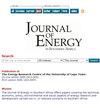升沉点吸收波能转换器优化设计的吸收功率密度法——以德班海特性为例
IF 0.6
4区 工程技术
Q4 ENERGY & FUELS
引用次数: 0
摘要
本文提出了一种圆柱起伏波能量转换器(WEC)的最佳尺寸方法。该方法基于最大化浮标的吸收功率密度(APD),以直径为决策变量。并对两种浮标形状进行了比较,得出了最佳方案。这两种浮标的形状是锥形圆柱形浮标(CCB)和半球圆柱形浮标(HCB)。因此,目的是确定最佳形状和最佳尺寸的圆柱形点吸收器。为了验证该方法的有效性,利用openWEC模拟器在南非德班海域3.6 m波浪有效高和8.5 s峰值周期条件下进行了模拟。两种形状的浮标直径范围为0.5 m至10 m。仿真结果表明,对于两种浮标形状,直径均为1m是最优解。此外,APD方法表明,HCB比CCB更有效。HCB的功率密度为1070 W/m2,几乎是CCB的两倍,而两种形状的吸收功率几乎相同。本文章由计算机程序翻译,如有差异,请以英文原文为准。
Absorbed power density approach for optimal design of heaving point absorber wave energy converter: A case study of Durban sea characteristics
This work proposes an approach for the optimal sizing of a cylindrical heaving wave energy converter (WEC). The approach is based on maximising the absorbed power density (APD) of the buoy, with the diameter being the decision variable. Furthermore, two types of buoy shapes were compared to get the best option. The two buoy shapes are the cone cylinder buoy (CCB) and the hemisphere cylinder buoy (HCB). The aim was therefore to determine the best shape and as well as the optimal size of the cylindrical point absorber. To validate the approach, the simulation was performed under Durban (South Africa) sea characteristics of 3.6 m wave significant height and 8.5 s peak period, using the openWEC simulator. The buoy diameter range considered was from 0.5 m to 10 m for both shapes. Simulation results revealed that a diameter of 1 m was the optimal solution for both buoy shapes. Furthermore, the APD method revealed that the HCB was more efficient than the CCB. The power density of the HCB was 1070 W/m2, which was almost double the power density of the CCB, while the two shapes present almost the same absorbed power.
求助全文
通过发布文献求助,成功后即可免费获取论文全文。
去求助
来源期刊

Journal of Energy in Southern Africa
ENERGY & FUELS-
CiteScore
3.00
自引率
0.00%
发文量
16
审稿时长
6 months
期刊介绍:
The journal has a regional focus on southern Africa. Manuscripts that are accepted for consideration to publish in the journal must address energy issues in southern Africa or have a clear component relevant to southern Africa, including research that was set-up or designed in the region. The southern African region is considered to be constituted by the following fifteen (15) countries: Angola, Botswana, Democratic Republic of Congo, Lesotho, Malawi, Madagascar, Mauritius, Mozambique, Namibia, Seychelles, South Africa, Swaziland, Tanzania, Zambia and Zimbabwe.
Within this broad field of energy research, topics of particular interest include energy efficiency, modelling, renewable energy, poverty, sustainable development, climate change mitigation, energy security, energy policy, energy governance, markets, technology and innovation.
 求助内容:
求助内容: 应助结果提醒方式:
应助结果提醒方式:


